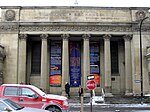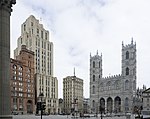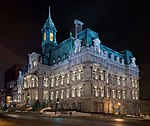Notre-Dame Basilica (Montreal)

Notre-Dame Basilica (French: Basilique Notre-Dame de Montréal) is a basilica in the historic district of Old Montreal, in Montreal, Quebec, Canada. The church is located at 110 Notre-Dame Street West, at the corner of Saint Sulpice Street. It is located next to the Saint-Sulpice Seminary and faces the Place d'Armes square. The interior of the church is amongst the most dramatic in the world and regarded as a masterpiece of Gothic Revival architecture. The vaults are coloured deep blue and decorated with golden stars, and the rest of the sanctuary is decorated in blues, azures, reds, purples, silver, and gold. It is filled with hundreds of intricate wooden carvings and several religious statues. Unusual for a church, the stained glass windows along the walls of the sanctuary do not depict biblical scenes, but rather scenes from the religious history of Montreal. It also has a Casavant Frères pipe organ, dated 1891, which comprises four keyboards, 92 stops using electromagnetic action and an adjustable combination system, 7000 individual pipes and a pedal board.Approximately 11 million people visit Notre-Dame Basilica every year, making it one of the most visited monuments in North America.
Excerpt from the Wikipedia article Notre-Dame Basilica (Montreal) (License: CC BY-SA 3.0, Authors, Images).Notre-Dame Basilica (Montreal)
Rue Saint-Sulpice, Montreal Ville-Marie
Geographical coordinates (GPS) Address External links Nearby Places Show on map
Geographical coordinates (GPS)
| Latitude | Longitude |
|---|---|
| N 45.504444444444 ° | E -73.556111111111 ° |
Address
Basilique Notre-Dame (Notre-Dame Basilica)
Rue Saint-Sulpice
H2Y 2V8 Montreal, Ville-Marie
Quebec, Canada
Open on Google Maps









